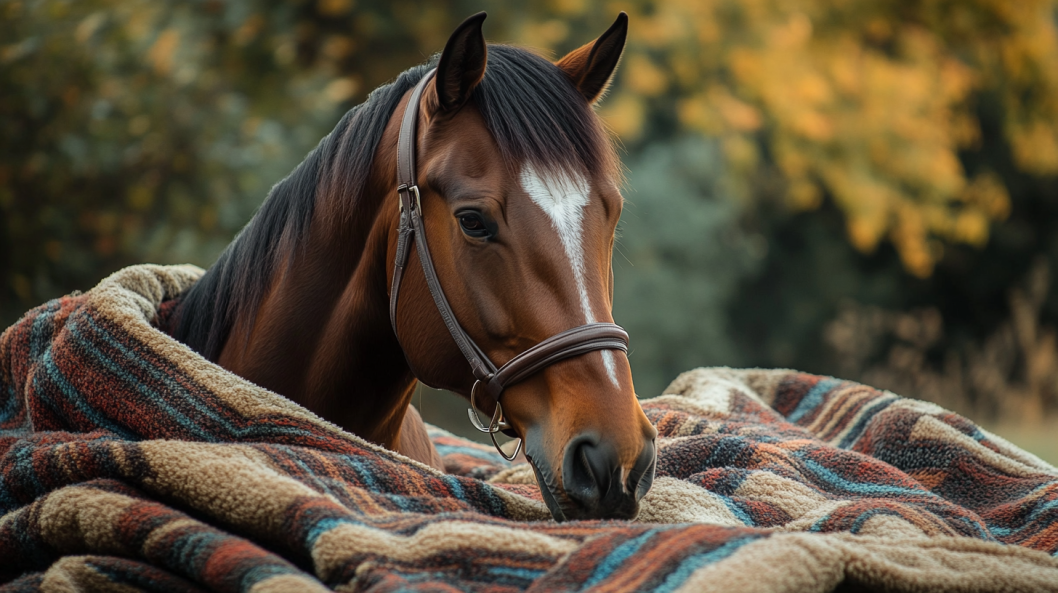Selecting the right horse blanket is crucial for keeping your horse comfortable and protected. A well-chosen blanket can help regulate your horse’s temperature, protect them from the elements, and improve their overall well-being. With so many options available, it can be overwhelming to make the right choice.
From my perspective, choosing the perfect blanket isn’t just about picking the most stylish or expensive option; it’s about understanding your horse’s specific needs and matching them with a blanket that offers functionality and durability. The proper blanket can significantly affect your horse’s happiness and health, whether braving the cold or cooling down after a workout. This comprehensive guide will help you navigate the different types of horse blankets and select the perfect one for your equine friend.
1. Understand the Different Types of Horse Blankets
Horse blankets come in various types, each designed for specific purposes. Understanding these types will help you choose the right one:
- Stable Blankets: These are designed for use inside the stable. They offer warmth and are usually made of soft, breathable materials. They are ideal for cool weather or when your horse stands still for extended periods.
- Turnout Blankets: These are durable and designed to withstand outdoor conditions. They are waterproof and often have a higher denier rating to resist wear and tear. They are perfect for horses out in the field.
- Coolers: Also known as sweat sheets, coolers wick moisture away from the horse’s body after exercise. They help cool down and dry off the horse.
- Sheet Blankets: Lighter than stable or turnout blankets, sheets provide minimal warmth but protect against flies, dust, and light rain.
- Thermal Blankets: These are insulated to provide extra warmth. They are often used in cold weather or for horses needing additional warmth.
2. Consider the Blanket Material
The material of the blanket affects its durability, breathability, and warmth:
- Polyester is commonly used in both stable and turnout blankets. It is durable, easy to clean, and somewhat resistant to water.
- Nylon is more durable than polyester and is often used in turnout blankets. It is smooth and less likely to cause rubs or sores.
- Fleece: This material is used in coolers and thermal blankets because it is soft and provides a good balance of warmth and breathability. It is also excellent at wicking moisture.
- Wool: Traditional and warm wool blankets are used primarily for their natural insulating properties. They’re less common but very effective in cold weather.
3. Sizing Your Horse Blanket
Getting the right size is crucial to ensure comfort and effectiveness:
- Measure Your Horse: Measure from the center of the chest, around the side of the horse, to the point of the buttocks. This measurement in inches will help you determine the correct size blanket.
- Check the Blanket Size Chart: Different brands may have slightly different sizing, so always refer to the size chart provided by the manufacturer.
- Allow for Adjustments: Some blankets come with adjustable straps for different body shapes and sizes. This feature can be particularly useful for a perfect fit.
4. Features to Look For
Certain features can enhance the usability and comfort of the blanket:
- Adjustable Straps and Closures: Ensure the blanket has adjustable belly straps, chest closures, and leg straps. This helps in fitting the blanket securely and comfortably.
- Tail Flap: A tail flap helps keep the blanket in place and provides extra protection from wind and rain.
- Neck Cover Compatibility: Some blankets have detachable or compatible neck covers for warmth and protection.
- Reflective Trim: Reflective elements improve visibility in low-light conditions, particularly if your horse is turned out in the early morning or late evening.
5. Maintenance and Care
To extend the life of your horse blanket, proper maintenance is essential:
- Regular Cleaning: Follow the manufacturer’s cleaning instructions. Most blankets can be machine-washed, but check for any specific requirements.
- Inspect for Damage: Regularly check for rips, tears, or worn areas. Repair any damage promptly to prevent further issues.
- Proper Storage: Store blankets in a dry, clean place to prevent mold and mildew.
6. Budget Considerations
Horse blankets come in a range of prices, so consider your budget while also factoring in the quality and durability you need:
- Invest in Quality: A well-made blanket can last several years, so sometimes it’s worth investing more for durability and effectiveness.
- Shop Around: If you’re on a tighter budget, look for sales, discounts, or second-hand options. Just ensure that any second-hand blankets are in good condition.
I believe investing in a high-quality horse blanket is more than just a purchase; it’s a commitment to your horse’s comfort and care. The perfect blanket meets your horse’s practical needs and reflects your dedication to their well-being. With thoughtful consideration and the right information, you can select a blanket that will keep your horse cozy and happy through every season.





